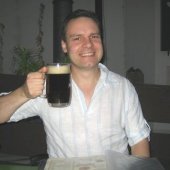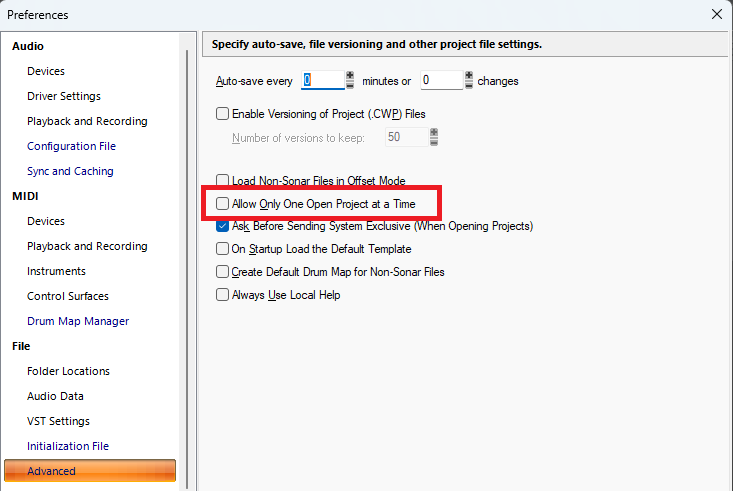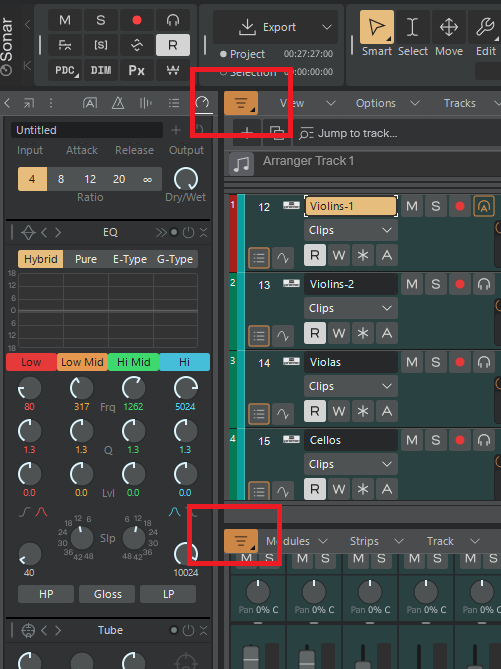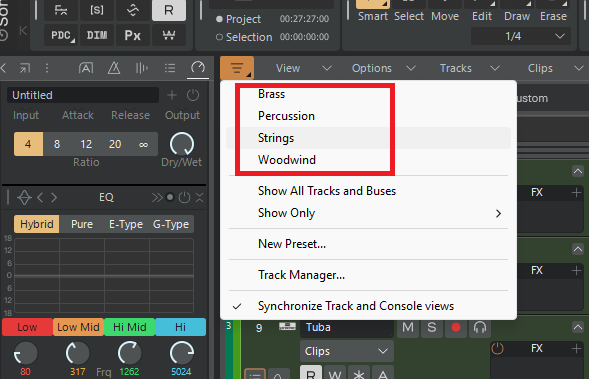-
Posts
7,186 -
Joined
-
Last visited
-
Days Won
39
Everything posted by msmcleod
-
A couple of things to bear in mind: 1. Keyboard shortcuts are basically a mapping between a key and command ID. Whilst command ID's don't change, some are deprecated over time as new features make older ones obsolete. All this means is, that a keyboard shortcut bound to a deprecated command ID won't do anything. 2. Keyboard shortcuts are view dependent, with the current view being the one that has focus. Key Down/Key Up events are windows messages that are sent to a particular window (a Sonar view is basically a window). This is usually the window that has focus, unless whatever is sending the event has been coded to send to a specific window. I'm not sure what options Auto HotKey has for sending to specific windows or changing window focus, but unless it can do this, it will limit what can do. Based on the amount of sleep commands I see in the scripts I've seen, I suspect it's relying on waiting for a particular window to gain focus, or for an operation to complete, so that when it sends the key event, it's being sent to the correct window. Obviously the sleep time is going to be dependent on how fast your particular machine is, and in some cases how big / complicated your project is. Normally making the sleep time longer will help to avoid any potential target window "misses", at the expense of the script taking longer to complete. Finally, having the same key combination doing different things for different views should be avoided. It's certainly possible, but it's dangerous in an Auto HotKey situation as you can't guarantee a particular view will have focus just relying on sleeps - and you certainly don't want a key combination being mapped for global and also mapped for a particular view.
-
There are two separate MIDI messages: - All Notes Off: turns off all notes - Reset Controllers: resets all continuous controllers "Zero All Controllers" sends the latter, which has no effect on Notes, unless there's a sustain CC event that hasn't been reset. For hardware MIDI devices both these messages are sent out. Obviously it's up to those synths to respond appropriately. For software synths, it's slightly different when Zero All Controllers is enabled. Pitch Bend, Modulation and Sustain are always reset. Reset Controllers is only sent out to soft synths if the Cakewalk.ini setting SendResetsToSoftSynths is set to 1. However again, it's up to those synths to respond appropriately.
-

Computer died - Can I reinstall old Sonar?
msmcleod replied to Philip G Hunt's topic in Computer Systems
Everything prior to SONAR Platinum has a serial number and authorisation key. SONAR Platinum has to be authorised using the very latest version of Cakewalk Command Center: https://legacy.cakewalk.com/Command-Center For SONAR 8 through to SONAR X3, your serial number and authorisation key should be displayed on your product page once you log on to legacy.cakewalk.com. For earlier versions of SONAR, your serial number will be on your product page, and your authorisation key should be with your original CD/DVD's. -

Computer died - Can I reinstall old Sonar?
msmcleod replied to Philip G Hunt's topic in Computer Systems
The short answer is yes (up to a point), however as always the devil is in the details. First of all, you need to make sure you have access to your old cakewalk account at legacy.cakewalk.com in order to download your old products. Your username / password will be the same as what you use for the Cakewalk Command Center. This may be different to your BandLab username/password that is used in Sonar / Cakewalk Product Center. If you've forgotten this, or have problems accessing your products/service packs, contact support@cakewalk.com Secondly, I doubt you'll need to go as far back as 2000 - you probably only need to as far back as Sonar X1 (released Dec 2010). Older versions (pre Sonar 8 ) may have compatibility issues with Windows 11. These older versions of Sonar rely on older versions for the Microsoft VC++ distributables which, while still available, may not be fully compatible with Windows 11. You can download all of the VC++ redists from Microsoft here: https://learn.microsoft.com/en-us/cpp/windows/latest-supported-vc-redist?view=msvc-170 . You shouldn't have issues installing these (and you may need them for earlier versions of Sonar to run at all), but don't expect them to work 100%. Finally, I'd recommend installing the VC++ redists first, then install the versions of Sonar in order (i.e. earliest first). If you really need the earlier versions of Sonar installed, consider installing Windows XP 32 bit (or even Windows 7 32 bit if you can get it to authorise) on a separate disk. This is what I've done. Unfortunately if you're using GPT formatted disks, you won't see your 32 bit versions on the boot screen on a dual boot, but you can press F8 every second or so on start up to pick the disk with Windows XP on it. -

BBC Symphonic synth Freeze not sounding the same
msmcleod replied to cabrol's topic in Cakewalk Sonar
I've just tried a similar thing with BBC SO, and the frozen result is the same as the live MIDI. Could you send a copy of your project to @Jonathan Sasor? We can take a closer look at what is going on. -

Cakewalk Sonar Default virtual piano keyboard
msmcleod replied to August Spencer's topic in Cakewalk Sonar
Can you let us know your monitor configuration - e.g.: Primary Monitor 1920 x 1080, 100% scaling (left), Secondary 3840 x 2160, 175% scaling (right) -

Opening multiple projects in free version of Sonar
msmcleod replied to IainThompson's topic in Cakewalk Sonar
-

BassMidi VSTI is missing instrument names/patches
msmcleod replied to RobertWS's topic in Cakewalk Sonar
It looks like BassMidi doesn't expose its patch list through the VST API. To get around this, you can use the Patch Browser in the inspector: 1. Select your Instrument / MIDI Track 2. If using an Instrument track, click on the MIDI tab in the inspector 3. Click on the "Patch Browser" button 4. Use the "List Patches From" dropdown to select the instrument definition you wish to use 5. Select the patch from the list by double clicking it -
To exclude a plugin: 1. Select "Cakewalk Plugin Manager" from the Utilities menu 2. Go to VST3 Instruments and navigate to the plugin you wish to exclude 3. Click "Exclude Plugin" 4. Click Close
-

Please add colour customization at least for PRV
msmcleod replied to Maria P's topic in Feedback Loop
You're probably thinking of Bars & Pipes Professional by Blue Ribbon Software on the Amiga... They were working on a Windows version (for win3.1 IIRC) when Microsoft bought them out; nothing ever came of the software except that the first (maybe first few) DirectX SDKs included some version of it for devs to implement things with (but I didn't find out about that till much later, after I was using Cakewalk 3 for windows, or I would've found a way to get that SDK just to use the B&P) I don't know CB's full history, but I thought they were concurrent with B&P's time, but CB was on the AtariST? The pre-cursor to Cubase was Steinberg Pro24, which definitely was on the Atari ST. IIRC Cubase 3 was the last version on the Atari. -
Meter changes always need to be on a measure boundary - they don't make sense otherwise. So unless everything lines up with measure boundaries both before & after the paste, the meter map may not match what you expect. Also, be mindful of what you're copying pasting... by default, copying/pasting a clip will NOT copy the meter changes with it. For example:
-

Please add colour customization at least for PRV
msmcleod replied to Maria P's topic in Feedback Loop
More colour customisation is coming: -

Sonar Not Saving Instrument When Exporting Track Template (Resolved)
msmcleod replied to henkejs's topic in Cakewalk Sonar
Working fine here... Not sure what to suggest here. May be try a full VST scan in case your plugin catalog has somehow gotten corrupt? -
The "generic low latency driver" is an aggregate driver - i.e. it's a wrapper around the WDM driver. It may behave like an ASIO driver, but it's talking to the WDM driver rather than the audio interface hardware directly. Sonar enumerates the drivers and their capabilities by opening each driver and determining the modes that are supported. This is done on start up of the application. When it opens the generic driver, the driver opens the device (and all other devices) using WDM. It then closes the driver in order to open the next ASIO device. The problem arises when, after closing the driver, and the driver doesn't let go of the WDM driver properly. You then get issues when opening the real ASIO device, as it may be using a different bit/sample rate than the one it's trying to use in ASIO, and although the drivers are separate, it's still just the one audio interface - e.g. it can't be at 16 bit/44.1K and 24 bit/48K at the same time. ASIO4ALL certainly is designed to be this way - i.e. when closed, it stays alive in the system tray with the WDM drivers open. The generic low latency driver (which I believe is a Steinberg device?) should behave more gracefully, however it's still at the mercy of how well the WDM drivers were written. The easiest thing is just not to use wrapper drivers, and stick to the manufacturer's genuine ASIO drivers.
-

Please add colour customization at least for PRV
msmcleod replied to Maria P's topic in Feedback Loop
-
There is no imposed device limit in Cakewalk or Sonar - they simply list the devices available from Windows. I've got 22 MIDI input/output devices listed on my office PC. I'm using MME as my MIDI driver mode.
-
From Google AI: The 16-device limit is a legacy problem often caused by "ghosted" or duplicate MIDI drivers in Windows' Device Manager, not a true Windows limit. To resolve it, you must show hidden devices in Device Manager (by typing set devmgr_show_nonpresent_devices=1 in Command Prompt) and then uninstall the greyed-out, unused MIDI devices. After deleting the duplicates, restart your computer to fix the limit and allow more devices to be connected. Steps to Fix the Limit Open Command Prompt as Administrator: Search for "CMD", right-click it, and select "Run as administrator". Enable Showing Hidden Devices: Type the command set devmgr_show_nonpresent_devices=1 and press Enter. Open Device Manager: Search for "Device Manager" and open it. Show All Devices: Click on the "View" menu and select "Show Hidden Devices". Locate and Uninstall Ghosted MIDI Devices: Expand the "Sound, video and game controllers" section. You will find greyed-out entries for unused MIDI or USB audio devices. Right-click on these greyed-out devices and select "Uninstall". In the dialog box that appears, make sure the option to delete the driver software is unchecked to keep the "real" port working. Delete Duplicate Entries: You may find multiple duplicate entries for a single device; delete the greyed-out ones. Restart Your Computer: After deleting the ghosted devices, restart your PC. Why This Happens Driver Duplication: When you uninstall a MIDI device, sometimes Windows doesn't fully remove its driver. Each time you reinstall the device, a new driver entry is created, leading to duplicates. Ghosted Devices: These duplicate entries count against a hidden device limit, even though the device is no longer in use. Legacy Limitation: This is often a remnant from older system designs and not a fundamental Windows limitation on the number of devices you can connect. FWIW - I've had a similar issue before, and the easiest way to stop it is to always use the same USB port for each device every time. A switched USB hub (i.e. with switches on each USB port) can help with this, as you can leave them plugged in and just use the switch to switch them on as needed. Just make sure it's just your MIDI devices on the hub, and not your audio interface!
-
If tracks are hidden, the track manager button will be lit. Clicking on it will unhide all hidden tracks; clicking again will hide the any tracks that were previously hidden. FYI - any hidden track presets you make in the track manager can be accessed quickly by right clicking this button:
-
The Sonitus plugins will remain in your plugin library as long as the operating system supports them. If your "Replace if possible on Project Load" setting with Preferences->File->VST Settings is unchecked, then your existing Sonitus plugins will remain unaffected. You'll be free to use either the old Sonitus plugins or the new ones. If your "Replace if possible on Project Load" setting with Preferences->File->VST Settings is checked, then loading any project with the old Sonitus plugins will result in them being replaced with the new Core plugins. Even if you had this checked, and migrated the Sonitus plugins to the new Core plugins in a particular project, there's nothing stopping you inserting the old Sonitus DX plugins... however these will be replaced with the Core plugins if that setting is checked when you next load the project.
-
Don't confuse the list of tempos in the Tempo Inspector with the tempo map - they're not the same. The list of tempos in the Tempo Inspector is a representation of the nodes / curves within the tempo track envelope. In most cases, the tempo map itself is then derived from that envelope, although there are exceptions: - When detecting tempo via Melodyne - When importing a MIDI file - When using "Set Beat at Now" - When using "Fit to Improvisation" - When loading an older pre-tempo track project ... in these five scenarios the tempo envelope is constructed from the tempo map. In saying that, there should be no issues inserting multiple tempos of the same value if you use the tempo track:
-

Resolved: Sonar Platinum Volume Automation question
msmcleod replied to Larry T.'s topic in Cakewalk Sonar
@Larry T. maybe I'm not fully understanding the issue, but what @Amberwolf says is correct: adjusting/automating the volume level alters volume by that amount, not to that amount. So the only time you'd see the db levels match between the volume fader and the meter readout is if the audio clip is at 0db. In saying that, it could be a completely different issue - have you checked you've not engaged offset mode at any point?







